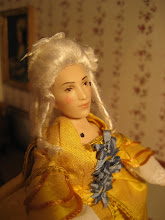Ensimmäisen adventin kunniaksi kertomusta Fjärilsgårdin kartanon väen joulusta.
The first advent seems to be a good time to start telling about Christmas at the Fjärilsgård manor.1700-luvulla joulu oli vuoden suurin juhla ja sitä valmisteltiin huolella. Juhla alkoi jouluaattona puolisen eli lounasajan jälkeen, jolloin puettiin ylle parhaimmat vaatteet.
In the 18th century Christmas was the biggest feast of the year and it was prepared properly. The actual feast started after lunch on Christmas Eve when everyone changed to their best dresses.Jouluisin salin ja ruokailuhuoneen siroteltiin usein havuja (katajaa tai kuusta) antamaan raikasta tuoksua.
The floors of drawing room and dining room were sprinkled with twigs (spruce or juniper) to give nice fresh scent.
Joulukuusi on elämän symboli. Joulukuusi tunnettiin Saksassa jo 1500-luvulla. Helsingin ensimmäinen joulukuusi – tai niitä oli peräti kahdeksan- oli paroni Otto W. Klinkowströmin kodissa vuonna 1929. Ensimmäiset kuuset olivat pieniä pöytäkuusia ja niiden jalkana oli vain ristikkäiset puut eli ne kuivuivat melko nopeasti. Tämän kartanon kuusi on kuitenkin iso komea kuusi, joita oli 1700-luvulla jo Ruotsissa.
The Christmas tree was a symbol of life. It was known already in 16th century in Germany but came later to the Nordic countries. The first Christmas tree in Helsinki– or actually eight of them – was found at the home of baronet Otto W. Klinkowström in 1929. The first trees were small and were standing on the wooden cross without any water so they dried easily. Therefore the Fjärilsgård tree is also standing on the piece of wood, but the tree is big as those in Sweden in 1700’s.Lapset, Amalia, Karl ja Mei Lin, koristelemassa kuusta,
the childern, Amalia, Karl and Mei Lin are decorating the Christmas tree


Tärkein kuusen koriste on ollut aina kynttilä. Alun perin kynttilät sidottiin oksiin ja tasapainotettiin riippuvalla omenalla. Kynttilänkiinnikkeet yleistyivät 1800-luvulla. Kartanon väki on siis hieman ajastaan edellä, kun heillä on jo nyt kynttilänpidikkeet :). Muut koristeet olivat usein syötäviä eli piparkakkuja ja omenoita. Omenat symboloivat paratiisin omenoita ja joulupallot jatkoivat aikanaan samaa symboliikkaa.
The most important decoration of the Christmas tree has always been the candles. At first they were tied up to the branches and balanced with a hanging apple. Candle holders become more common in 1800’s. The folk at the manor is a bit ahead of their time :). Other decorations were edible such as gingerbreads and apples. Apples symbolised paradise apples and the symbolism continues with nowadays Christmas baubles. 

Joululahjat oli tapana kääriä ruskeaan puotipaperiin. Aattoiltapäivä on kiireistä lahjojen paketoinnin aikaa. Lahjat suljettiin narulla, lakattiin kirjelakalla ja säilytettiin pärekorissa, kunnes ne juuri ennen jakamista laitettiin kuusen alle. Lahjat jaettiin aattoiltana jouluaterian jälkeen. Jokaisen lahjan mukana tuli lahjan saajaa ajatellen tehty värssy eli runo tai mietelause, joka luettiin kaikkien kuullen. Usein tämä värssy oli tärkeämpi kuin itse lahjan sisältö. Aaton iltapäivänä siis myös riimiteltiin ahkerasti. Lahjat tehtiin itse ja ne olivat usein käsitöitä tai leikkikaluja. Varakkaissa kodeissa annettiin myös kirjoja ja koruja.
Christmas presents were wrapped with brown shop paper. The Christmas Eve afternoon was busy time with wrapping. The parcels were closed with cord, decorated with sealing wax and they were stored in chip basket until they were pun under tree. The gifts were given after the Christmas dinner on the Christmas Eve. With every gift came a poem which was read in front of all guests. Many times the poem was more important than the content of the parcel. Thus the afternoon was also busy time with rhyming. The gifts were homemade, usually needlework, knitted items, wooden toys etc. In very wealthy families also books and jewellery were given.

Lähteet:
Koivisto K., Nyman H. 2009. Joulupuu on rakennettu. Tammi.
Nirkko J., Vento U. (toim.)1994. Joulu joutui. Juhlatietoa, kuvia ja kertomuksia. SKS.





















































